Construction is the process of building and/or repairing map features and other infrastructure. The rules explain how each of these tasks is accomplished in Rule 14A I. Repair is a relatively simple procedure normally requiring the expenditure of a certain amount of movement points (MPs) to accomplish the desired task. (For all purposes, the term "construction unit" below should be read as "any engineer units with construction ability" including combat engineers, but not assault engineers.)
There are three (optionally four) items that can be both damaged and repaired: air bases, ports, rail lines, and optionally, bridges.
Airbases. Airbases (including intrinsic capacities, permanent and temporary airbases) may be damaged by any unit (not just construction units) expending two additional movement points (MPs) in the airbase hex. (Airbases could also be damaged by other things, such as bombing.) Only a construction unit may repair a damaged airbase, by expending 2 MPs to remove each
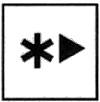 Rail lines. Rail lines can be broken, that is, damaged,
by any unit expending an additional 2 MPs in the hex.
Any construction unit (not just a railroad engineer) can
repair a rail line by expending 4 MPs in the hex to remove the hit
of damage.
Rail lines. Rail lines can be broken, that is, damaged,
by any unit expending an additional 2 MPs in the hex.
Any construction unit (not just a railroad engineer) can
repair a rail line by expending 4 MPs in the hex to remove the hit
of damage.
Ports. The capacity of ports can be damaged, but only by construction units (or bombing, etc.). Since damaging a facility as extensive as a typical European port requires some specialized knowledge, non-construction units can't hurt a port. Each hit of damage requires the expenditure of 3 MPs by the construction unit. To repair hits of damage on a port, a construction unit must expend an additional 4 MPs per hit of damage repaired in the hex. Note that repairing damage to a port does not require a Port Construction Unit.
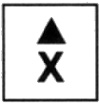 Bridges. If Optional Rule 44A.1 "Bridges" is 'in
use, then bridges can be damaged and repaired. Any unit may
damage a friendly owned or un-owned bridge by expending 4
additional MPs in either hex adjacent to the bridge hexside. A
bridge that is demolished (or has bombing hits) may be repaired;
any construction unit may repair the bridge (or remove all
bombing hits) by expending 4 additional MPs for a bridge across
a non-major river, or 8 MPs for a bridge across a major river. The
engineer units must be in a hex adjacent to the bridge hexside,
and both hexes adjacent to the bridge must be friendly owned.
When repairing a bridge across a major river, the construction
units must also be able to trace an overland supply line to a
resource point, which is expended when the repairs are begun.
Bridges. If Optional Rule 44A.1 "Bridges" is 'in
use, then bridges can be damaged and repaired. Any unit may
damage a friendly owned or un-owned bridge by expending 4
additional MPs in either hex adjacent to the bridge hexside. A
bridge that is demolished (or has bombing hits) may be repaired;
any construction unit may repair the bridge (or remove all
bombing hits) by expending 4 additional MPs for a bridge across
a non-major river, or 8 MPs for a bridge across a major river. The
engineer units must be in a hex adjacent to the bridge hexside,
and both hexes adjacent to the bridge must be friendly owned.
When repairing a bridge across a major river, the construction
units must also be able to trace an overland supply line to a
resource point, which is expended when the repairs are begun.
(Note that causeways, that is, transportation lines crossing lake or all-sea hexsides are not considered bridges and may not be damaged or demolished in the context of any published Europa game.)
Other repair issues. A couple of notes on repair. First of all, note than construction units do not need to be in supply to perform repair tasks, although they may have reduced abilities by virtue of having reduced MPs available if at supply level U-2 or worse (U-1 for c/m engineers). Second, keep in mind that all repair costs are doubled during poor weather - poor weather being defined as mud, frost, winter, or snow. Therefore, repairing a rail line, which normally costs 4 MPs. would instead cost 8 MPs to repair during poor weather. The full MP cost must be paid before the item is repaired, even if this requires more than one player turn to accomplish. Simply record in some convenient manner the number of MPs spent per turn and complete the repair task once the required number of MPs has been spent.
New Construction
In addition to repairing items, construction units may also construct new items, specifically airbases and forts.
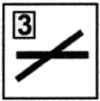 Temporary Airbases. Temporary airbases can
be constructed in allowable hexes by construction units.
During the movement phase (not the exploitation phase!) the
construction unit expends an additional 6
MPs in the hex and the temporary airbase is placed on the map in
that hex. (Optionally, construction units can build temporary
airbases incrementally, spending 2 MPs for each air unit's worth
of capacity. Show this by placing the temporary airbase with hits
of damage. For example, if a construction unit builds a temp
airbase by expending only 2 MPs in the hex, put down a three
capacity temporary airbase with 2 hits of damage. No resource
points are needed to build temporary airbases.
Temporary Airbases. Temporary airbases can
be constructed in allowable hexes by construction units.
During the movement phase (not the exploitation phase!) the
construction unit expends an additional 6
MPs in the hex and the temporary airbase is placed on the map in
that hex. (Optionally, construction units can build temporary
airbases incrementally, spending 2 MPs for each air unit's worth
of capacity. Show this by placing the temporary airbase with hits
of damage. For example, if a construction unit builds a temp
airbase by expending only 2 MPs in the hex, put down a three
capacity temporary airbase with 2 hits of damage. No resource
points are needed to build temporary airbases.
Except in Weather Zone F, construction units must "maintain" temporary airbases for those bases to remain in existence. A construction unit maintains a temporary airbase simply by ending the player turn stacked with it. This action does not require the expenditure of any MPs and may be performed by any construction unit, and not necessarily the construction unit that built the temp airbase. A construction unit could therefore maintain the airbase and in the same turn use its MPs to, say, build a fort in the airbase's hex. Also, maintenance of a temporary airbase could be performed by a construction unit arriving from the rear area, while the construction unit that built the air base uses its MPs to move forward, closer to the advancing front, and even begin building another temporary airbase in another hex.
In weather zone 'F' (the desert) the conditions are a little different. Historically, it proved so easy to maintain landing grounds in and North Africa that no construction unit is needed for short-term maintenance in desert areas. Instead, every Jan 11 and Jul turn each player rolls on the success table for each temporary airbase on the map that is not occupied by a construction unit. An "F" failure means the airfield takes one hit of damage. An "F*" Failure results yields two hits of damage. See WitD rule 43C7b for the details.
 Permanent Airbases and Forts. Construction
units can build permanent airbases and forts in allowable terrain.
The procedure is identical for each so we describe them here
together. It takes one turn to build a permanent airbase or a fort in
clear or rough terrain, and two turns in any other allowable terrain.
The construction unit must be in (general) supply and able to
trace an overland supply line to a resource point, which is
expended when the construction task is begun. Construction
units begin constructing airbases or forts in friendly initial phases
and, assuming good weather, the completed airbase or fort is
placed on map during the next friendly initial phase.
Permanent Airbases and Forts. Construction
units can build permanent airbases and forts in allowable terrain.
The procedure is identical for each so we describe them here
together. It takes one turn to build a permanent airbase or a fort in
clear or rough terrain, and two turns in any other allowable terrain.
The construction unit must be in (general) supply and able to
trace an overland supply line to a resource point, which is
expended when the construction task is begun. Construction
units begin constructing airbases or forts in friendly initial phases
and, assuming good weather, the completed airbase or fort is
placed on map during the next friendly initial phase.
 The act of construction consumes all of the MPs of the
constructing unit; it may not move at all while constructing the
airbase/fort (unless the task is abandoned) and it has no MPs
available for any other purpose. The unit may move normally
once the construction task is completed, beginning with the
movement phase immediately following the initial phase in which
the construction task was completed. A construction unit may
also abandon the construction task, by leaving the hex before the
construction task is completed; the item is not completed and no
resource point is recovered.
The act of construction consumes all of the MPs of the
constructing unit; it may not move at all while constructing the
airbase/fort (unless the task is abandoned) and it has no MPs
available for any other purpose. The unit may move normally
once the construction task is completed, beginning with the
movement phase immediately following the initial phase in which
the construction task was completed. A construction unit may
also abandon the construction task, by leaving the hex before the
construction task is completed; the item is not completed and no
resource point is recovered.
 Construction units may also, in some games, augment the
capacity of airbases. Augmenting an airbase increases its
capacity by three. This is handled as if another airbase was being
constructed in the airbase hex, follow the procedure outlined
above for building an airbase. No hex may have an airbase
capacity of greater than twelve, counting all capacity, both
intrinsic and that from airbases. Once augmented, replace the
existing airbase counter with one of the next higher capacity. For
example, when a three capacity airbases is augmented, replace it
with a six capacity air base.
Construction units may also, in some games, augment the
capacity of airbases. Augmenting an airbase increases its
capacity by three. This is handled as if another airbase was being
constructed in the airbase hex, follow the procedure outlined
above for building an airbase. No hex may have an airbase
capacity of greater than twelve, counting all capacity, both
intrinsic and that from airbases. Once augmented, replace the
existing airbase counter with one of the next higher capacity. For
example, when a three capacity airbases is augmented, replace it
with a six capacity air base.
Note than when building items, the construction unit must be in supply (general, regular or special, as the case may be, depending on specific game being played).
Weather Effects. All construction tasks, including building items, take twice as long in poor weather. For example, building a fort in a mountain hex, which normally requires two turns, would require four turns during poor weather. Temporary airbases may not be built nor repaired during mud weather; they may be maintained however. What constitutes "allowable terrain", mentioned above, changes from game to game; refer to Rule 14A of each specific game for a list of where these items may be built.
Terrain effects. It takes one game turn to build a fort or permanent airbase in clear or rough terrain and two game turns in any other terrain. The movement point costs for building temporary airfield are doubled for any terrain other than clear or rough. Terrain has no effect upon repair costs.
Battalions. The costs described above are based upon one RE of construction units performing the task. Any of the above construction tasks would take twice as long, or twice as many MPs, if performed by a one half RE construction unit - a construction battalion. A construction battalion building a fort in woods in poor weather would teeter atop eight "fort under construction" markers at the beginning of its project!
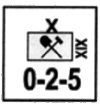 Quick Construction. Additional construction unit
REs can also decrease construction costs, by using Quick Construction.
Two construction unit REs operating together each pay only half the
MPs required of a single unit to complete a task, or if the task is based
upon turns, they accomplish the task in half the number of turns. For
tasks that require only one turn, a special procedure is used; the two
REs of construction units complete the task in the same initial phase in
which they begin the task, and have one half of their MPs available. In
other words, they expend one half of their MPs to complete the
construction task. The completed item is placed on map as soon as
completed, that is, in that initial phase. We have included some "1/2 MP
available" markers in the template at the end of this article. You can use
these markers to mark units using quick construction.
Quick Construction. Additional construction unit
REs can also decrease construction costs, by using Quick Construction.
Two construction unit REs operating together each pay only half the
MPs required of a single unit to complete a task, or if the task is based
upon turns, they accomplish the task in half the number of turns. For
tasks that require only one turn, a special procedure is used; the two
REs of construction units complete the task in the same initial phase in
which they begin the task, and have one half of their MPs available. In
other words, they expend one half of their MPs to complete the
construction task. The completed item is placed on map as soon as
completed, that is, in that initial phase. We have included some "1/2 MP
available" markers in the template at the end of this article. You can use
these markers to mark units using quick construction.
As an exception to the normal rules regarding quick construction, some units (of large size) are able to perform quick construction on their own, without the assistance of another construction capable RE. Any "Construction" or "Port Construction" brigade with a defense strength of two or more is treated as two REs of construction units by themselves. Both of these conditions must be fulfilled; and let us emphasize this! This special rule does not apply to "Combat Engineer" brigades with defense strengths of two or more. It does not apply to "Construction Engineer" regiments of any strength nor does it apply to "Construction Engineer" brigades with defense strengths less than two.
For certain nationalities and in certain circumstances, civilian labor can provide the second RE of construction units. These civilians are not represented by any unit or counter. In Fire in the East / Scorched Earth, Soviet major city hexes provide civilian labor; in Second Front, German major city hexes provide civilian labor. This capability is based upon city size and may only be used within four hexes of the city, by construction units making use of the civilian labor. Check the game's specific rules for further details.
Construction costs cannot be further decreased, that is, the maximum number of construction capable REs that may participate in a construction task is two. Additional construction units have no effect. Also, remember that the building of permanent airbases and forts must always begin in friendly initial phases, even when quick construction is to be used. Temporary airbases are built during friendly movement phases only and may not be built during initial phases.
Example.
Let's look at an example that will illustrate oth some of the construction principles we have discussed, and also show how to keep track of ongoing construction tasks. The US 0-1-8 Construction III is going to build a fort in the woods hex that it occupies during this Allied initial phase. During the appropriate step of the Sep I initial phase, the Allied player announces the construction task and expends the resource point (in this case two hexes away, in Chaumont). The weather is clear and the construction unit is in supply.
In SF, building a fort in non-clear, non-rough terrain takes two turns. A "fort under construction" marker is placed on the 0-1-8 Cons to indicate that it is performing, but has not completed, the building of the fort. If this was a clear or rough hex, the fort would be completed next turn, Sep II, at which point the "fort under construction" marker would be flipped over to reveal the completed fort. However, this fort will take two turns to build, due to the woods terrain.
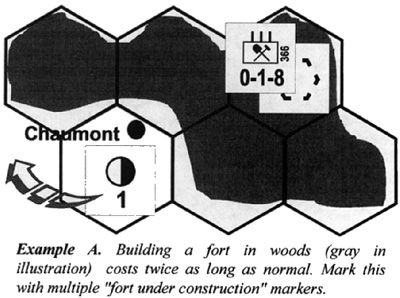 Example A. Building a fort in woods (gray in illustration)
costs twice as long as normal. Mark this with multiple "Fort
under construction" markers.
Example A. Building a fort in woods (gray in illustration)
costs twice as long as normal. Mark this with multiple "Fort
under construction" markers.
If the fort takes two turns to build how can we show this? A good method is to place an additional "fort under construction" marker in the hex. During the next friendly initial phase (Sep II), remove the additional "fort under construction" marker, leaving only one in the hex. In the second following initial phase, that is, Oct I, flip over the remaining "fort under construction" marker to reveal the completed fort. This system can be adapted to covering construction tasks of any length.
For example, let us imagine that it is poor weather, using the same example above. Now the 0-1-8 Cons III will be busy for four turns building that fort (two turns for non-clear/rough terrain, doubled for poor weather). Show this by placing a total of four fort-under-construction markers in the hex, removing one in each subsequent friendly initial phase, until only one is left; then flipped over the last one to reveal the fort when construction is completed.
This works for forts, but permanent airbases present a problem, since they have another item, temporary airbases, on their back. Players will have to come to some agreement as to how to show these items as "under construction". We have provided a template for some "Airbase Under Cons." markers at the end of this article.
Still using our above example, let's add in another RE of engineers and make use of Quick Construction (QC). Now, in addition to the 0-1-8 Cons unit, there is a British 2-3-8 Eng X present. Since Combat Engineer units are considered to be construction units, it may assist the Cons III in building the fort. Assuming clear weather still, the time it takes to accomplish this task is halved, from two turns to one turn. A fort under construction marker is placed in the hex in the friendly initial phase and flipped over to a completed fort during the following friendly initial phase, that is, in the Sep II turn.
 Note that in both situations described above, none of the
construction units may leave the hex of construction before the
task is completed, unless the task is abandoned. Also note well
that it is these specific construction units that must
remain in the hex; if the engineer/s that began the construction
leaves the hex for any reason before the task is completed, then
the task is abandoned, the resource point lost, the task is not
completed and any time spent on the task is wasted.
Note that in both situations described above, none of the
construction units may leave the hex of construction before the
task is completed, unless the task is abandoned. Also note well
that it is these specific construction units that must
remain in the hex; if the engineer/s that began the construction
leaves the hex for any reason before the task is completed, then
the task is abandoned, the resource point lost, the task is not
completed and any time spent on the task is wasted.
Example
In this example, it is Jun I and clear weather. The German Cons III and the German 2-10 mot Eng III are in a clear hex and wish to build a fort. Using QC, the task will be completed in half the time. Since building a fort in clear terrain during clear weather normally takes one turn, these units will complete the task this friendly initial phase. The resource point in Rome is expended and a completed fort marker is placed in the hex. Each of the Construction units now has half of their MPs available for movement in the immediately following Axis movement phase. The 0-1-5 Cons III will have 2 1/2MPs and the 2-8 Eng III will have 4MPs available.
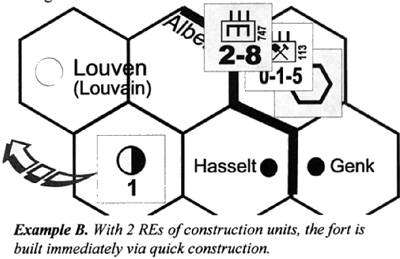 Example B. With 2 REs of construction units, the fort is built immediately via quick construction.
Example B. With 2 REs of construction units, the fort is built immediately via quick construction.
Note that having begun a construction task in this initial phase, these units may not begin another one, in the same initial phase, even though they have MPs remaining. For example, neither of these units, individually or together, could begin another construction task, like building a permanent airbase. Any construction unit may only begin one construction task per friendly initial phase.
A handy sequence to follow in each initial phase is this: start by completing all construction tasks currently under construction that finish this initial phase. Once this is accomplished, begin construction of new tasks, on a hex by hex basis. If you follow the common convention of turning counters in their hex at an angle to indicate completed movement, then do so at this time for all construction units that have begun a task taking one or more turns. Mark construction units using quick construction to both begin and complete a task in the current initial phase in some convenient manner, so that you remember that they have half MPs available.
More Engineers
-
Europa Engineers: Introduction
Europa Engineers: Types of Engineers
Europa Engineers: Construction: Damage and Repair
Europa Engineers: Combat Effects, Considerations, and Complaints
Back to Europa Number 56 Table of Contents
Back to Europa List of Issues
Back to MagWeb Master Magazine List
© Copyright 1997 by GR/D
This article appears in MagWeb (Magazine Web) on the Internet World Wide Web. Other military history articles and gaming articles are available at http://www.magweb.com